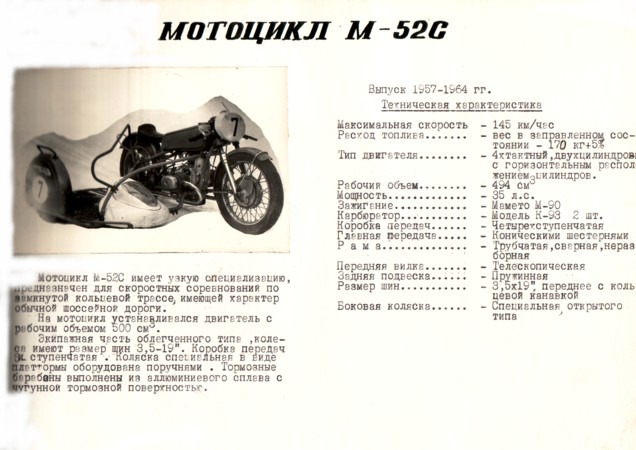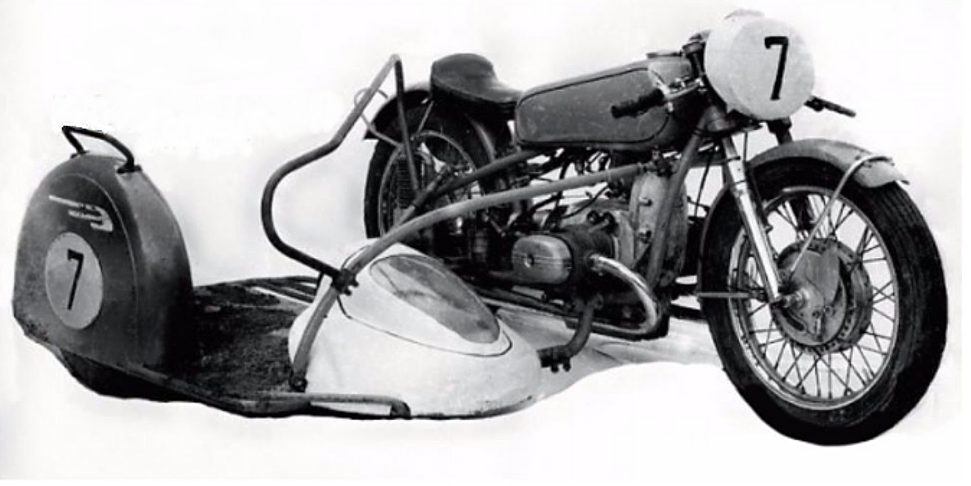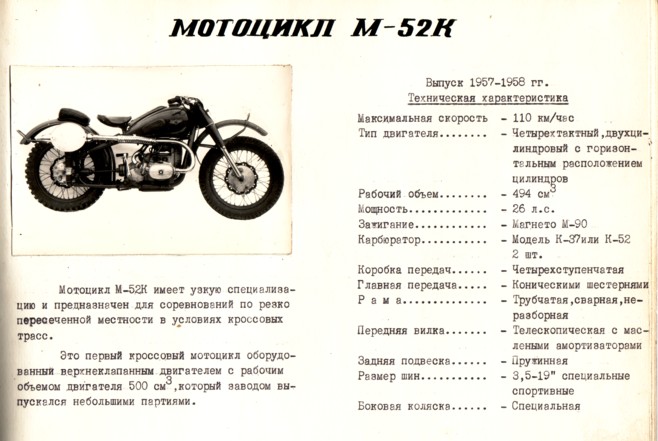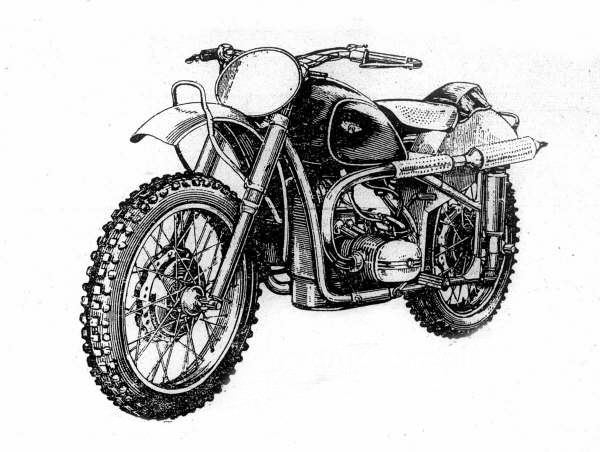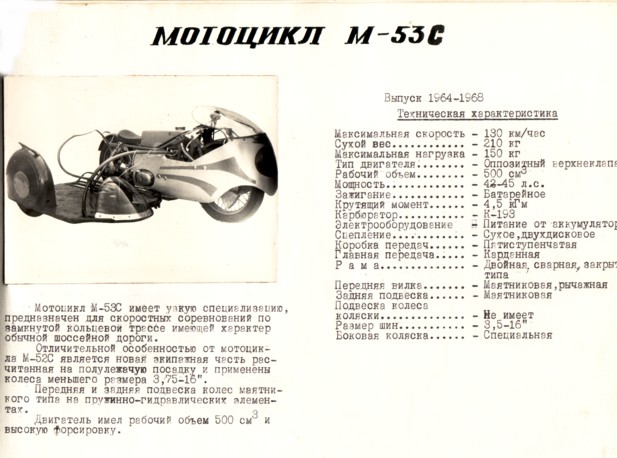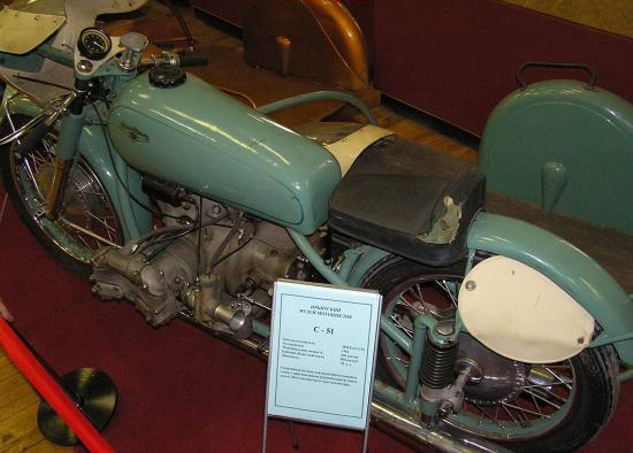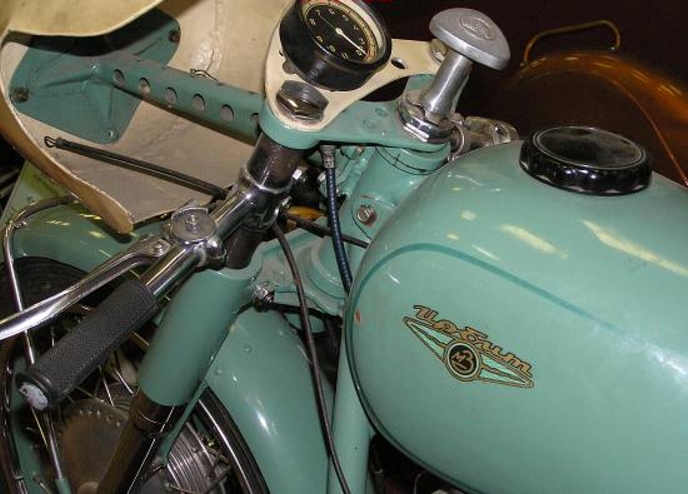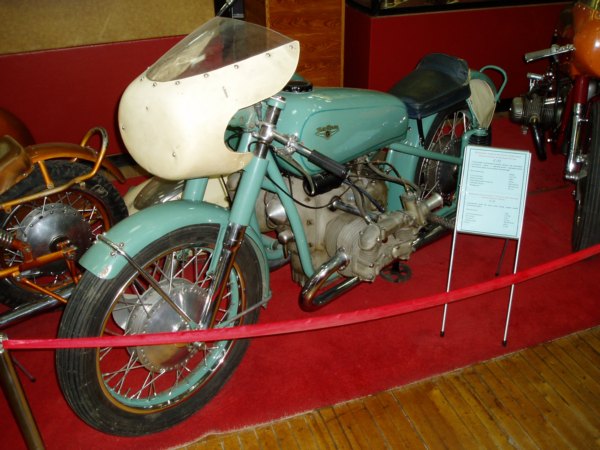M-52C, M-53C, C-51 roadracing motorcycles and motocrosser M-52K
Russian C is S in English, so also referred to as models M-52S, M-53S and M-52K (cross)
In the early 1950s, the Soviet Central Design Bureau for the production of motorcycles (Serpukhov Institute, Moscow Region) set an assignment for research work to create two new types of roadracing motorcycles with 500cc class horizontally-opposed engines that should be unified with mass produced M-72 machines, to satisfy demand from growing motosports clubs interests.
Two motorworks (Irbit and Kiev), then manufacturing M-72 motorcycles, were superordinated for this task. It was decided that Irbit Motorworks would start the manufacturing of 500cc bikes (the machine to be unified with M-72) and Kiev Motorworks would handle the manufacturing of a brand new model.
The story of the development of these base 500cc models can be found here: M-52,-53 500cc [ https://b-cozz.com/m-52-m-53-500cc/# ]
On this page we take a closer look at the 500cc sports motorcycles that came from this plan.
But first we should look to connections with the German marque BMW. Not only the already Soviet-made model M-72 of wartime period based on the BMW R71, but also later developments by BMW, whose 500cc class motos became legendary and gathered a cult following among moto enthusiasts.
1954 M-52 | USSR ☭
M-52C (M-52S, Eng.) has a narrow specialization and is designed to be used for competitions on circuited tracks with conventional highway surface. The motorcycle has a 500cc engine. Undercarriage is lightened, wheel size 3,5-19”, five-speed gearbox. Special sidecar is made in shape of platform with hand rails (tubes). Brakes have aluminum cast drums with cast iron working surface inside. Issued 1957-1964 years.
Irbit Motorworks built the first test M-52 in 1954. Its engine was designed by the Central Design Bureau. Manufacturing of M-52C, a road racing model, was started in 1957.
This machine had M-77 chassis; the front fork was equipped with the M-52 wheel axle displaced forward (on some versions). The engine was an upgraded mass-produced M-52 engine. As for the speed performance, the bike was equal to the legendary BMW R37 that was considered one of the best motorcycles during the 1930s and after the Great Patriotic War (WWII). Top speed – 145 km/h.
The M-52S engine had new unique valve covers with three longitudinal ribs, featured on Ural motorcycles for over the next 40 years until the new 750cc models were launched in 1998. these familiar rocker covers were last featured on the 2002 IM3.8.123 “Solo Classic”. By using the compression ratio 9.0 and twin carburetor configuration, M-52C engine output increased to 35 hp at 6,200 rpm, which sped the machine up to 160 km/h. In addition, a high octane fuel had an impact on power and speed.
The M-52C engine was based on the base M-72 motor for maximum compatibility of spare parts; the mass produced crankcase was used, which had modifications which were made at the last of production stages. Diameters of the crankshaft small ends and piston pins, piston rings and oil separators are all unified with corresponding parts used in the M-72.
For the M-52C a valve train almost identical to the one used in the 1951 BMW R-51/3 was used; additionally, it had some technological advantages. It featured aluminium-cast cylinders with cast-iron liners, a deep sump and a sporty slimmer, slender elongated fuel tank, and enhanced rider posture.
Concept M-52C participated in roadracing circuit races even before serial production was launched. In 1955 V. Viluchin took first place at the competitions near Tallin.
From 1957 till 1961, only 20 machines were manufactured, and each M-52S motorcycle was assembled by hand.
another reliable source states:
“A total of 678 M-52 motorcycles were produced of which less than 200 were sports and cross-country versions. The production of models M-52 ended in 1961. Three versions – M-52 [standard roadster], M-52C [roadracer] and M-52K [cross] were produced”.
M–52K (Cross)
Description: Motorcycle M-52K has a designed narrow specialization for races in harsh cross-country environment of motocross tracks. This was in the first motorcycle series equipped at the IMZ-Ural factory with a 500cc engine, which was issued in small series. M-52K was issued 1957-1958.
M-53C
A further determined effort was revealed in 1964, roadracing motorcycle M-53C
Description: Motorcycle M-53C (Eng. M-53S) has a narrow design specialization to be used for competitions on circuited tracks with conventional highway surface. It differs from previous model M-52C in undercarriage designed for semi-prone driver’s position, smaller but wider wheel size used – 3,75-16”. Front and rear suspension – pendulum type with spring-hydraulic shock absorbers. Engine capacity was 500cc and a high degree of tuning. Top speed – 130 km/h. Power – 42–45hp. Torque – 4,5 kgm. Issued 1964-1968 years.
Then the thunder struck!
C-51
Motorcycle C-51 (S-51, Eng.) was used for competition events on a circuit track with conventional highway surface. A distinctive feature of the model is its engine with overhead placed camshafts driving valves directly. Such design scheme offers to radically increase revolutions and results in greater power. Top speed 140 km/h. Power – 50 hp at 10000rpm. Torque – 5,4 kgm. Issued 1963-1966 years.
These are a representative overview of the Soviet 500cc racers. Almost every motorcycle was in some way unique or altered, kitchen designers improvements, aerodynamic shields, fuel boosters, nitro pills?
There is a lot of history and heroic racing recorded in these machines. We are always looking to expand the knowledge and memories of the 500’s racing glory. If you have photos or other stories please send them in.
sources:
- Irbit Motorcycle Plant archives
- Steve Wiggins, Irbit, Russia – data sheets
- Alexei Popov. Riga Latvia
- V.Sheynov
- Motoworld
- USSR sportsbikes
- Th-Photos Creative Commons Attribution-3.0
- b-Cozz archives
translations by ©Evgenij Radchenko, Russia
Retrieved from the archives and expanded, re-edited by JD, final editing by Cat


